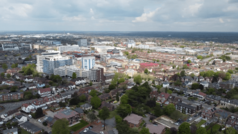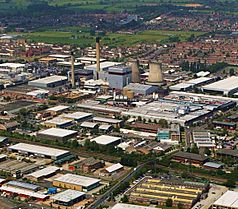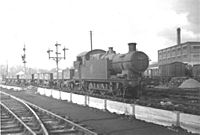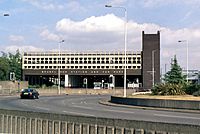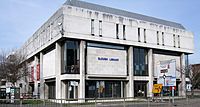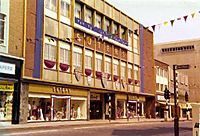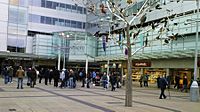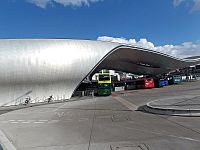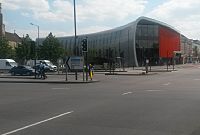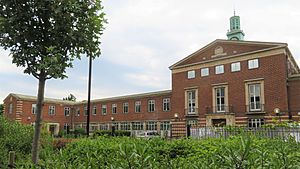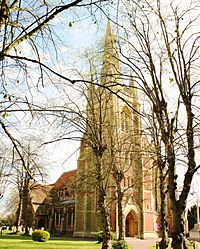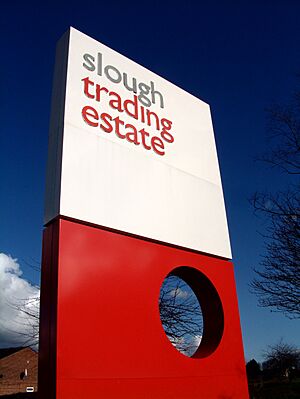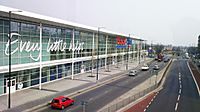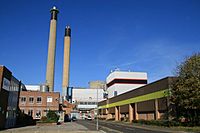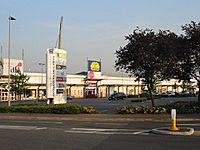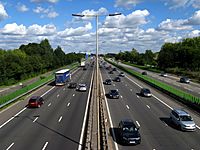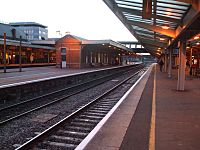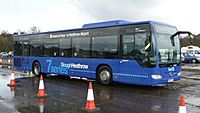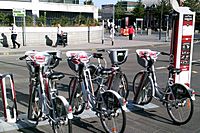Slough facts for kids
Quick facts for kids Slough |
|
|---|---|
|
From top, left to right: Slough skyline, St Mary's Church, Old Town Hall, Gas Works and surrounding area, Queensmere Shopping Centre, High Street, St Ethelbert's Church and Slough Trading Estate. |
|
| Area | 11.71 sq mi (30.3 km2) |
| Population | 143,184 (2021 Census) |
| • Density | 12,227/sq mi (4,721/km2) |
| Unitary authority |
|
| Shire county | |
| Region | |
| Country | England |
| Sovereign state | United Kingdom |
| Post town | SLOUGH |
| Postcode district | SL1–SL3 |
| Dialling code | 01753 |
| EU Parliament | South East England |
| UK Parliament |
|
Slough (/slaʊ/) is a busy town in Berkshire, England. It is located in the Thames Valley, about 20 miles (32 km) west of central London. Slough is easy to reach because it's near major motorways like the M4, M40, and M25. In 2021, the town had a population of 143,184 people.
Slough is known for its very diverse population. People from all over the UK and the world have moved here for work since the 1920s. This has helped Slough become a major trading and business hub. In 2017, the number of people without jobs was very low, much less than the UK average.
The town has the most UK head offices of global companies outside of London. The Slough Trading Estate is the largest industrial area in Europe owned by a single private company. It provides over 17,000 jobs in 400 businesses. Big companies like Blackberry, McAfee, Burger King, DHL, Telefonica, and Lego have their main offices in Slough.
Contents
Slough's Past: A Quick Look
The name "Slough" was first written down in 1195 as Slo. It referred to a small village between Upton and Chalvey. In 1086, the Domesday Book mentioned Upton. King Henry III had a palace in Cippenham during the 1200s. Some parts of Upton Court were built in 1325. St Mary the Virgin Church in Langley was likely built in the late 1000s or early 1100s.
From the mid-1600s, stagecoaches started to travel through Slough. It became a place where coaches would stop to change horses on their way from London. By 1838, when the Great Western Railway opened, the population of Upton-cum-Chalvey was 1,502. In 1849, a train line was built from Slough to Windsor & Eton Central. This was very handy for Queen Victoria as it was right opposite Windsor Castle.
Slough has 96 buildings that are officially "listed," meaning they are important historical sites.
- Four are Grade I listed: St Laurence's Church, St Mary the Virgin Church, Langley, Baylis House, and Godolphin Court.
- Seven are Grade II* listed: St Mary's Church, Upton Court, the Kederminster and Seymour Almshouses, St Peter's Church, Ostrich Inn, and King John's Palace.
- Many other buildings, like Slough railway station, are Grade II listed.
In 1918, a large area of farmland west of Slough became an army repair depot. It was used to store and fix many vehicles returning from the First World War. In 1920, the government sold this land to the Slough Trading Co. Ltd. They continued to repair old army vehicles until 1925. Then, the company (renamed Slough Estates Ltd) was allowed to create an industrial estate. This led to huge growth and many jobs, bringing workers from all over the UK and other countries. Slough Town Hall was finished in 1937.
During the Second World War, Slough was hit by air raids, especially in October 1940. An emergency hospital was set up in Slough to treat people injured in London.
After the war, many new homes were built for people moving from war-damaged London. From 1955 to 1957, Slough was used for a big road safety test called the Slough experiment.
The old Slough library, named the Robert Taylor Library, opened in 1974. It was taken down in 2017 as part of a plan to rebuild the town centre.
Modern Changes and Redevelopment
In the 2000s, Slough's town centre has seen a lot of new building work. Older buildings are being replaced with modern offices and shopping areas. For example, Tesco built a much larger store. The Heart of Slough Project is a big plan to rebuild the town centre. It aims to make it a cultural hub for creative industries, with new buildings and public spaces. This £400 million project started in 2010.
In 2009, Herschel Park was redesigned to look like its original Victorian era style. The park is named after the famous astronomer William Herschel.
A new bus station was built as part of the Heart of Slough project. Work began in March 2010, and it opened in May 2011.
Some groups, like The Twentieth Century Society, have criticized these large-scale changes. They believe that many good historical buildings have been destroyed in Slough. They feel the town is trying to erase its past instead of keeping important parts of it.
In 2016, the Queensmere and Observatory shopping centres in Slough were sold for £130 million.
Slough's Location and Surroundings
Slough is about 20 miles (32 km) west of central London. It is also close to Windsor (2 miles/3 km north), Maidenhead (5 miles/8 km east), and Reading (19 miles/31 km north-east). Heathrow Airport is only 5 miles (8 km) away. Nearby towns include Uxbridge and Beaconsfield.
Most of Slough was historically part of Buckinghamshire. However, the town grew by joining together several villages along the Great West Road. These original villages, now part of Slough, include Chalvey, Cippenham, Colnbrook, Langley, Poyle, Upton, and Wexham.
Other areas within Slough are Brands Hill, Britwell, Huntercombe, Manor Park, Salt Hill, Upton Lea, and Windsor Meadows. Slough's urban area also connects to nearby villages like Burnham, Farnham Royal, Stoke Poges, and Datchet.
Weather in Slough
The closest weather station to Slough is at Heathrow Airport, about 5 miles (8 km) east. This part of the Thames Valley often has some of the warmest summer temperatures in the British Isles. In July, the average high temperature is around 23.5 °C (74.3 °F).
Slough also gets less rain than most of the UK, with less than 600 mm (24 inches) per year. There are about 105 days each year with more than 1 mm of rain.
| Climate data for Heathrow Airport, elevation: 25 m (82 ft), 1991–2020 normals, extremes 1948–present | |||||||||||||
|---|---|---|---|---|---|---|---|---|---|---|---|---|---|
| Month | Jan | Feb | Mar | Apr | May | Jun | Jul | Aug | Sep | Oct | Nov | Dec | Year |
| Record high °C (°F) | 16.0 (60.8) |
20.1 (68.2) |
22.8 (73.0) |
27.4 (81.3) |
31.8 (89.2) |
34.8 (94.6) |
37.9 (100.2) |
37.9 (100.2) |
31.3 (88.3) |
28.8 (83.8) |
18.6 (65.5) |
16.6 (61.9) |
37.9 (100.2) |
| Mean daily maximum °C (°F) | 8.4 (47.1) |
9.0 (48.2) |
11.7 (53.1) |
15.0 (59.0) |
18.4 (65.1) |
21.6 (70.9) |
23.9 (75.0) |
23.4 (74.1) |
20.2 (68.4) |
15.8 (60.4) |
11.5 (52.7) |
8.8 (47.8) |
15.7 (60.3) |
| Daily mean °C (°F) | 5.6 (42.1) |
5.8 (42.4) |
7.9 (46.2) |
10.5 (50.9) |
13.7 (56.7) |
16.8 (62.2) |
19.0 (66.2) |
18.7 (65.7) |
15.9 (60.6) |
12.3 (54.1) |
8.4 (47.1) |
5.9 (42.6) |
11.7 (53.1) |
| Mean daily minimum °C (°F) | 2.7 (36.9) |
2.7 (36.9) |
4.1 (39.4) |
6.0 (42.8) |
9.1 (48.4) |
12.0 (53.6) |
14.2 (57.6) |
14.1 (57.4) |
11.6 (52.9) |
8.8 (47.8) |
5.3 (41.5) |
3.1 (37.6) |
7.8 (46.0) |
| Record low °C (°F) | −13.2 (8.2) |
−9.6 (14.7) |
−5.1 (22.8) |
−2.6 (27.3) |
−0.9 (30.4) |
1.5 (34.7) |
5.6 (42.1) |
5.9 (42.6) |
1.8 (35.2) |
−3.3 (26.1) |
−7.0 (19.4) |
−11.8 (10.8) |
−13.2 (8.2) |
| Average precipitation mm (inches) | 58.8 (2.31) |
45.0 (1.77) |
38.8 (1.53) |
42.3 (1.67) |
45.9 (1.81) |
47.3 (1.86) |
45.8 (1.80) |
52.8 (2.08) |
49.6 (1.95) |
65.1 (2.56) |
66.6 (2.62) |
57.1 (2.25) |
615.0 (24.21) |
| Average precipitation days (≥ 1.0 mm) | 11.5 | 9.5 | 8.5 | 8.8 | 8.0 | 8.3 | 7.9 | 8.4 | 7.9 | 10.8 | 11.2 | 10.8 | 111.7 |
| Mean monthly sunshine hours | 61.1 | 78.8 | 124.5 | 176.7 | 207.5 | 208.4 | 217.8 | 202.1 | 157.1 | 115.2 | 70.7 | 55.0 | 1,674.8 |
| Source 1: Met Office | |||||||||||||
| Source 2: KNMI | |||||||||||||
Who Lives in Slough?
Faith in Slough (2021) Christianity (31.96%) No Religion (13.08%) Islam (29.44%) Sikhism (11.35%) Hinduism (7.79%) Buddhism (0.49%) Judaism (0.05%) Other Religions (0.45%) Religion not Stated (5.39%)
According to the 2021 census, Slough has a population of 158,400 people. It is one of the most ethnically diverse areas in the UK outside of London.
- 46.9% of the population is Asian.
- 35.9% is white.
- 7.5% is black.
- 4% is mixed race.
- 1.2% is Arab.
- 4.5% are from other ethnic backgrounds.
Even with its diverse population, English is the most common language spoken. Over 110,212 people said English was their first language in 2021. Other common languages include Punjabi, Polish, and Urdu.
| Country of birth | Number resident |
|---|---|
| 87,350 | |
| 17,107 | |
| 14,418 | |
| 8,912 | |
| 3,551 | |
| 1,940 | |
| 1,385 | |
| 1,336 | |
| 1,125 | |
| 1,064 |
The 2021 census also showed the different religions in Slough:
- 32% are Christian.
- 29.4% are Muslim.
- 11.4% are Sikh.
- 7.8% are Hindu.
- 0.5% are Buddhist.
- 0.1% are Jewish.
- 0.5% follow other religions.
- 13% have no religion.
- 5.4% did not answer.
You can find more details on the Demographics of Slough page.
How Slough is Governed
Slough is governed by one main local council: Slough Borough Council. This council is based at Observatory House in the town centre. Most of the urban area is directly managed by the council. However, some suburbs, like Britwell and Wexham Court, have their own local parish councils.
History of Slough's Local Government
Slough was originally a small village within the parish of Upton, in Buckinghamshire. As Slough grew, it needed more organized local government. In 1863, a local board was set up to manage the town. This board was made up of elected members.
In 1894, this local board became an urban district. The Slough urban district grew over time, taking in nearby areas like Chalvey in 1900, and Langley, Salt Hill, and Cippenham in 1930. In 1938, the urban district became a municipal borough, which is a type of town council.
In 1974, the Slough borough became a larger non-metropolitan district. It also moved from Buckinghamshire to Berkshire. In 1995, the area grew again to include Colnbrook with Poyle.
Since 1998, Slough Borough Council has been a "unitary authority." This means it handles all local government services for the area, without needing a separate county council.
Since 2015, Slough has had a Youth Parliament. This group helps represent the ideas and opinions of younger people in the town.
Partner Towns
Slough is connected with another town in a "twinning" partnership:
Slough's Economy and Jobs
Before the 1800s, Slough's main industries were making bricks and farming. The bricks used to build Eton College were made here. As more people traveled on the Great West Road, inns and pubs opened to serve them. Later, plant nurseries were important. The famous Cox's Orange Pippin apple was first grown near Slough around 1825.
In the mid-1800s, James Elliman was a major employer. He started as a fabric seller but then made his famous Elliman's Embrocation, a horse liniment. Elliman gave a lot to the town, and local roads and schools are named after him.
In 1851, a cattle market started near the railway station. It became very popular, with sales every Tuesday. The Slough Cattle Market ran until 1988.
In 1906, James Horlick opened a factory near Slough Railway Station to make his malted milk product. This factory stopped making Horlicks in 2017.
From the 1920s, Slough Estates Ltd (now Segro) developed the Slough Trading Estate. This estate helped protect Slough from economic downturns. For many years, Slough's economy was mostly based on manufacturing.
In the last 20 years, Slough's economy has changed from manufacturing to information-based jobs. Many factories have closed, and office buildings are taking their place. Hundreds of big companies have chosen the Slough Trading Estate because it's close to Heathrow Airport and has good motorway links. In the 1960s, Gerry Anderson's film company made shows like Thunderbirds in Slough.
The UK headquarters of Mars, Incorporated is in Slough. They started making the Mars Bar here over 70 years ago. Some of their production has moved to the Czech Republic. Many major IT companies, like BlackBerry, McAfee, and O2, have their European head offices in Slough.
New offices have recently opened for companies like Nintendo, Black and Decker, and Abbey business centres.
The car industry has also been important in Slough. Until 1966, Citroën assembled cars here and still has its UK headquarters in the town. Ford built lorries in Langley for many years. Now, companies like Ferrari, Mercedes, Fiat, and Maserati have offices in Slough.
Getting Around Slough
Slough is a town where many people travel for work. It's about 20 miles (32 km) west of Central London and close to Heathrow Airport. Many people travel to Windsor, Reading, Bracknell, and London from Slough.
Road Travel
Buses, taxis, and private cars are used for travel within Slough. Buses also connect Slough to Heathrow Airport. You can take buses or Greenline coaches to Central London, but trains are usually faster. Slough is bordered by the M4 motorway and is served by junctions 5, 6, and 7. Other main roads include the A4, A355, and A412.
Train Travel
Slough has train stations at Burnham, Slough, and Langley. Slough railway station is a key stop where you can change trains for Windsor & Eton Central.
- To Reading: Fast trains take about 15 minutes.
- To London Paddington: Express trains take about 14 minutes.
Slough also has services on the Elizabeth line, a new train line that opened across central London in 2022. There are plans for a new rail project, the Western Rail Approach to Heathrow, which will connect Slough directly to Heathrow Airport in about six minutes.
Cycling
National Cycle Network route 61 goes through central Slough. A bike-sharing system was started in October 2013. It helps people travel between the trading estate and nearby train stations.
Canal
The Slough Arm canal connects Slough to the main Grand Union Canal. This canal runs from the River Thames to Birmingham. The Slough Arm was reopened for boats in 1975 after being unused since 1960.
Sports in Slough
Slough has a local football team called Slough Town F.C.. They play in the National League South. Slough is also home to the ice hockey team, the Slough Jets. They play in NIHL South Division 1.
Grace Moloney, a goalkeeper for Reading F.C. Women and the Republic of Ireland Women's team, was born and lives in Slough.
Learning in Slough
Slough has many primary and secondary schools. Among them are four state grammar schools. East Berkshire College also has a campus in the area. Slough schools are often among the top 10 best performers in the country for GCSE exam results. In 2011, 68.1% of students left school with at least 5 A*-C grades, including English and maths. The national average was 58.9%.
The Thames Valley University (Slough Campus) is currently closed due to the "Heart of Slough" project. A new campus was planned to open in 2013 as part of the University of West London, but as of March 2022, the old university site was sold for housing.
Images for kids
See also
 In Spanish: Slough para niños
In Spanish: Slough para niños


